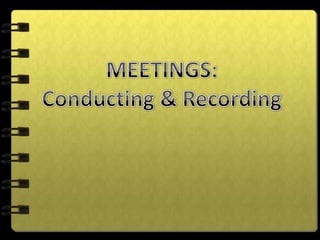
Meetings uwsb
- 2. Held in every organization, as per requirements Include board meetings, training sessions, goal-oriented meetings, etc Have become increasingly complex over the years!
- 3. WHARTON CENTRE FOR APPLIED RESEARCH Published findings in The Wall Street Journal Average CEO spends 17 hours/week in meetings Senior executives spend avg. 23 hours/week Middle managers spend 11 hours/ week Senior and middle managers reported that only 56% of the meetings were productive. They added that a phone call or memo could have replaced 25% of the meetings they attended!
- 4. To move group actions forward Present information Review, evaluate, discuss & decide Social reasons (orientations, goal visioning, communication, motivational, etc) Types Hurdles Information sharing Problem solving
- 5. Plan for both- meeting content and meeting process 1. BE SPECIFIC Objective Outcome
- 6. 2. CREATE AN AGENDA Things to be discussed Prioritize agenda items Time frame for each item Assign realistic amounts of time to each agenda
- 7. 3. PREPARE IN ADVANCE Benefit 1 • Smooth conduction of meeting Benefit 2 • Time wastage elimination Benefit 3 • Productivity enhancement
- 8. 1. Who should participate? Whose inputs are required? Who is needed to decide? Whose consent is required to move forward? 2. What should be the process? Clarify who will lead the meeting Will the leader also act as facilitator? Decide the appropriate format of meeting as per requirement (participative or directive) 3. Roles in a meeting? Facilitator Recorder Leader Participants Timekeeper (opt.)
- 9. 4. Pre and post Meeting Communication Pre Meeting • Agenda • Participants • Time and Place • Preparation of materials • List of audio/visual equipment available to presenters • Requests for any special needs During Meeting • Record • Decisions • Action items • Open issues Post Meeting • Post or mail minutes of meeting to all
- 10. Starting time Opening Remarks Getting down to business Participation (balanced??) Agenda Closing
- 11. 1. TO MEET OR NOT TO MEET Has a goal been set? Has an agenda been created ahead of time? Will the appropriate people be attending? Can the information be covered in an email or memo?
- 12. Control • Conduct yourself • Stand while others sit • Take the head of the table chair Collaborative • Ask a team member to conduct • Sit with others • Sit on either side of the table 2. NON VERBAL COMMUNICATION Transmit neutral and appropriate body language
- 13. 3. REACHING RAPID CONSENSUS Break the myth Indicate moving forward and doing it together Integrating other departments of the organization
- 14. Online surveys Feedback forms Efficiency of task allotted as a result of meeting
- 16. Most integral part of an effective meeting process Record every detail- details of discussions, who said what, final decision Tip: Carry the agenda along with you
- 17. Understand the type of information you need to record at the meeting. Meeting minutes usually include the following: Date and time of the meeting Names of the meeting participants and those unable to attend (e.g., “regrets”) Acceptance or corrections/amendments to previous meeting minutes Decisions made about each agenda item, for example: Actions taken or agreed to be taken Next steps Voting outcomes – e.g., (if necessary, details regarding who made motions; who seconded and approved or via show of hands, etc.) Motions taken or rejected Items to be held over New business Next meeting date and time
- 18. Create an outline Check-off attendees as they enter the room Record decisions or notes on action items in your outline as soon as they occur to be sure they are recorded accurately Ask for clarification if necessary – for example, if the group moves on without making a decision or an obvious conclusion, ask for clarification of the decision and/or next steps involved. Don’t try to capture it all Record it – literally, if you are concerned about being able to keep up with note taking, consider recording the meeting (e.g., on your smart phone, iPad, recording device, etc.)
- 19. Minutes need headings so that readers can skim for the information they need. Your template may include these: 1. Topics_________________ 2. Decisions______________ a. b. c. 3. Actions Agreed Upon a. Person responsible b. Deadline 4. Next Meeting -Date and Time________________ -Location______________ -Agenda items_____________
- 20. Write the minutes as soon as the meeting is over Review your outline Check to ensure all decisions, actions and motions are clearly noted. include a short statement of each action taken by the board and a brief explanation of the rationale for the decision when there is extensive deliberation before passing a motion, summarize the major arguments
- 21. Edit to ensure brevity and clarity, so the minutes are easy to read Be objective. Write in the same tense throughout Avoid using people’s names except for motions or seconds. This is a business document, not about who said what. Avoid inflammatory or personal observations. The fewer adjectives or adverbs you use, the better. If you need to refer to other documents, attach them in an appendix or indicate where they may be found. Don’t rewrite their intent or try to summarize them.
- 22. Do write minutes soon after the meeting--preferably within 48 hours. Do use positive language. Rather than describing the discussion as heated or angry, use passionate, lively, or energetic--all of which are just as true as the negative words. Don't skip writing minutes just because everyone attended the meeting Don't describe all the "he said, she said" details (Record topics discussed, decisions made, and action items) Don't include any information that will embarrass anyone (for example, "Then Terry left the room in tears").
